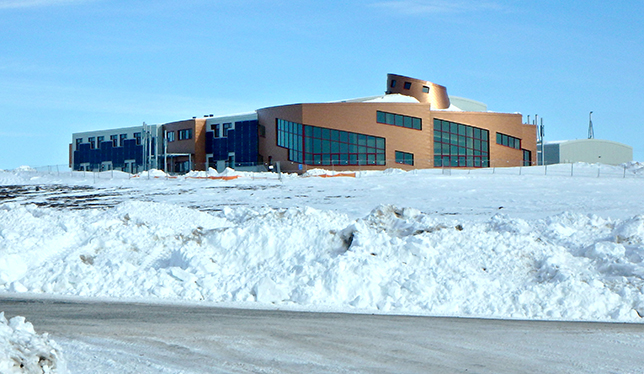This October, as the sun begins to settle low on the horizon and the snow piles up in the Nunavut hamlet of Ikaluktutiak (Cambridge Bay), the Canadian government will officially throw open the doors to its new $250-million Arctic research station. The copper-toned main research building at the heart of the complex, outfitted with slick laboratories and a traditional knowledge centre, aims to attract researchers from across Canada – and the world – to generate new information about the North and put it in the hands of decision-makers.
Researchers at the Canadian High Arctic Research Station, or CHARS, will study Arctic issues, including the impacts of climate change on the land, ocean and lakes around Cambridge Bay. Renewable energy, northern infrastructure and the cryosphere (permafrost, snow and ice) are also among its science and technology priorities.
The station’s location will bring researchers to the edge of the Northwest Passage, an increasingly popular marine corridor for tourist vessels and cargo ships, and an area that hasn’t been extensively studied, said Warwick Vincent, a professor of biology and holder of the Canada Research Chair in Aquatic Ecosystem Studies at Université Laval. “It shows a long-term, substantive commitment to Arctic research,” he said.

Yet researchers within the Canadian Arctic science community are concerned that Arctic research funds are tapering off. ArcticNet, created in 2003 through the federal Networks of Centres of Excellence Program, will have its funding wound down in 2018 after receiving a total of $113 million for Arctic research over its lifespan. As well, the Climate Change and Atmospheric Research initiative, created by the former Conservative government, runs out of funds this year and has not been renewed. The program supported, among other things, the Polar Environment Atmospheric Research Laboratory, which is now threatened with closure, said Katie Gibbs, executive director of the science advocacy group Evidence for Democracy.
With the heavy cost of CHARS, researchers worry that many smaller projects and stations may be overshadowed. Others point out that fixed infrastructure in one part of Canada’s vast Arctic does little to stimulate field research in remote areas. “As university academics working in the North, we are in a worrisome time. Major funding opportunities are drying up and there is a focusing of resources towards CHARS,” said Dr. Vincent. Nevertheless, the new research station is “a net positive,” he said.
The station’s roots date back to 2007 in the speech from the throne announcing the government’s commitment to building a “world-class” Arctic research station. After considering several possible sites, the then Conservative government announced in 2010 that it would break ground in Cambridge Bay, along the shores of the fabled – and increasingly busy – Northwest Passage.
The multi-building station can house researchers year-round and will indeed provide them with “world-class” facilities to study Arctic issues. The main building contains a necropsy lab with a mounted crane to transfer muskoxen, seal and other large animals onto the dissection table. There is also a cold lab for studying insects, seeds and ice cores, an ultra-clean lab for examining environmental contaminants, and a growth chamber where scientists can investigate the effects of carbon dioxide and warming on plant growth. A genomics lab, a geographic information systems lab, and rows of specimen freezers and refrigerators round out the space.
“It is super-handy to have a facility to do necropsies,” said Susan Kutz, an associate professor in the faculty of veterinary medicine at the University of Calgary who studies the impact of climate change on the health of muskoxen, caribou and other wildlife. Up until now, abnormal specimens had to withstand the long trip down to Saskatoon, Calgary or Guelph, Ontario, for further investigation. Some of the more advanced analysis can now be done on-site, said Dr. Kutz.
In addition to laboratory space, the facility offers housing for up to 48 researchers at a time, office space and access to equipment, including snowmobiles and all-terrain vehicles for transportation. The subsidized housing, which has been available to researchers since April 2016, has “totally changed the way we do research,” said Dr. Kutz.
Accommodation in northern communities can restrict the number of days researchers and their students spend in a community because of the high costs. If a storm rolls in and outgoing flights are canceled, budgets can be stretched to the breaking point.
CHARS is operated by Polar Knowledge Canada, an agency whose board reports to Carolyn Bennett, the minister of the newly created department of Crown-Indigenous Relations and Northern Affairs (the federal government recently announced it was splitting the department of Indigenous and Northern Affairs in two). The station is also now part of the Canadian Network of Northern Research Operators, a collection of several dozen institutes, observatories and ocean-going vessels in the Canadian Arctic and sub-Arctic.
Polar Knowledge Canada has a budget of $29 million as of next year to cover operating costs, staff salaries and research grants. In the most recent call for proposals, the agency selected 43 projects from 197 applications for two years of funding, its president, David Scott, said.
Projects that ask questions that are relevant to Canada’s northern communities are among Polar Knowledge Canada’s priorities. One project, headed up by Trevor Bell at Memorial University, maps changing sea ice in the coastal zone with an eye to keeping people safe as they travel across it on snow machines. Another project tracks the effects of wildfire on northern aquatic ecosystems. Dr. Scott said two streams of funding – short-term and longer-term – may become available in the future.
“The bigger vision is getting northerners themselves involved,” said Dr. Scott. “They have questions that they want answers for, and they have knowledge, particularly in the environmental domain.”